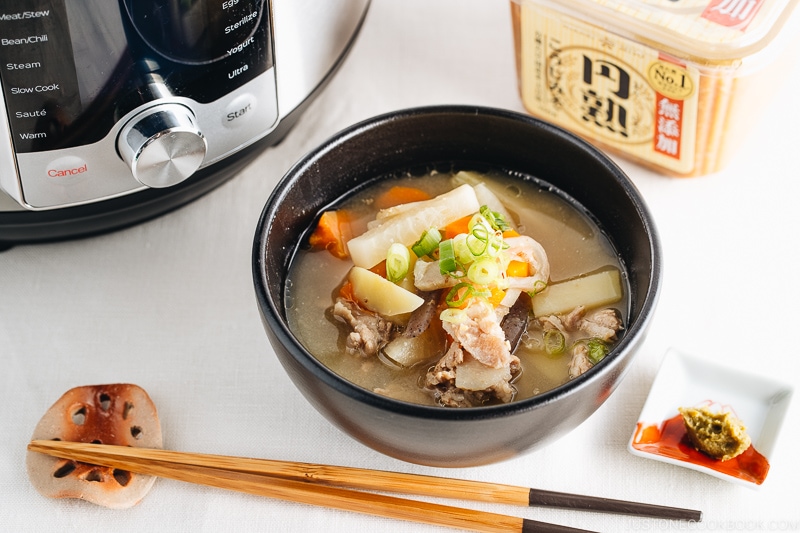
Tonjiru (sometimes called Butajiru) is a hearty pork and vegetable miso soup. With just 1 min in the Instant Pot, it will be the ultimate, comfy soup for fall and winter months!
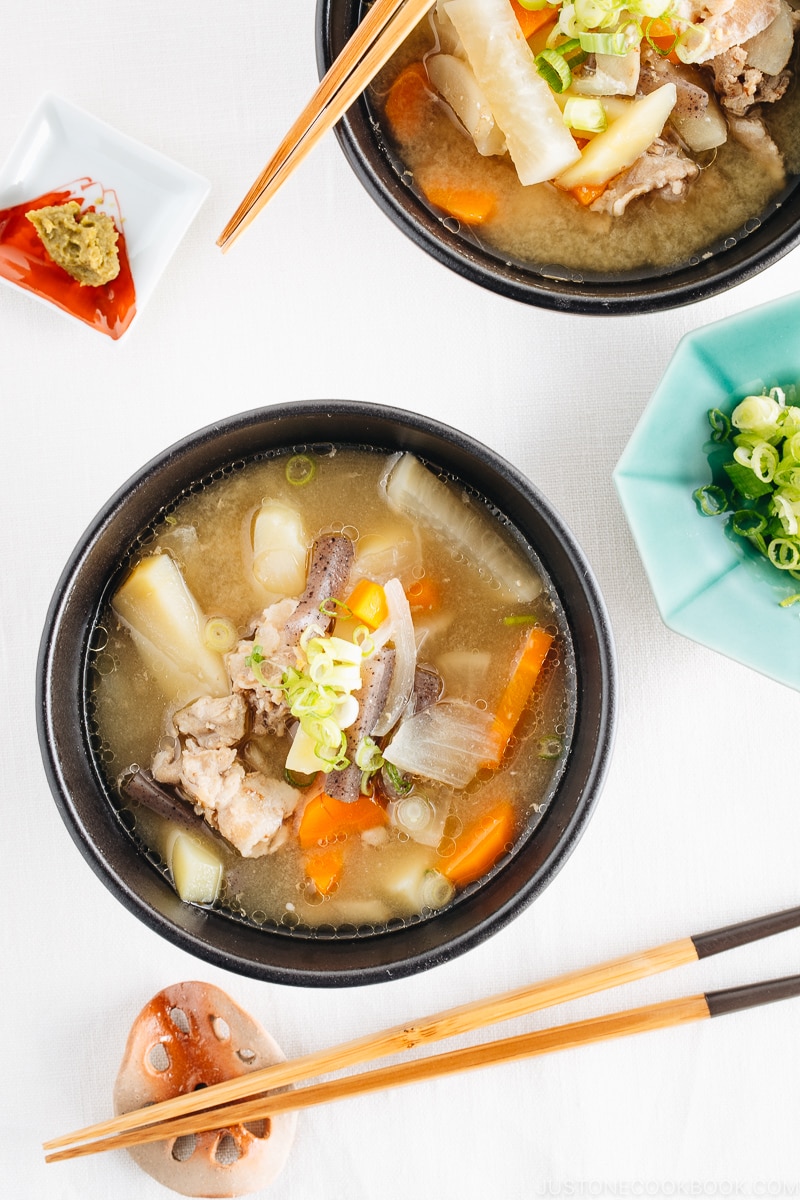
When I was in college, I used to make a big pot of this pork and vegetable miso soup and ate it throughout the week. Not only it was a hearty miso soup for the soul and brainpower, but it also gave me good nutrients from the meat and all kinds of vegetables. This all-mighty miso soup is called Tonjiru (豚汁) or sometimes called Butajiru.
I’ve already shared a regular Tonjiru recipe that requires cooking on the stovetop, but today I’ll share the Instant Pot Tonjiru recipe. Although the actual cooking time is roughly the same as the stovetop method, the benefit of cooking Tonjiru in the electric pressure cooker is you can walk out of the kitchen once you press “start,” and go back to study, work, or spend the time with your family.
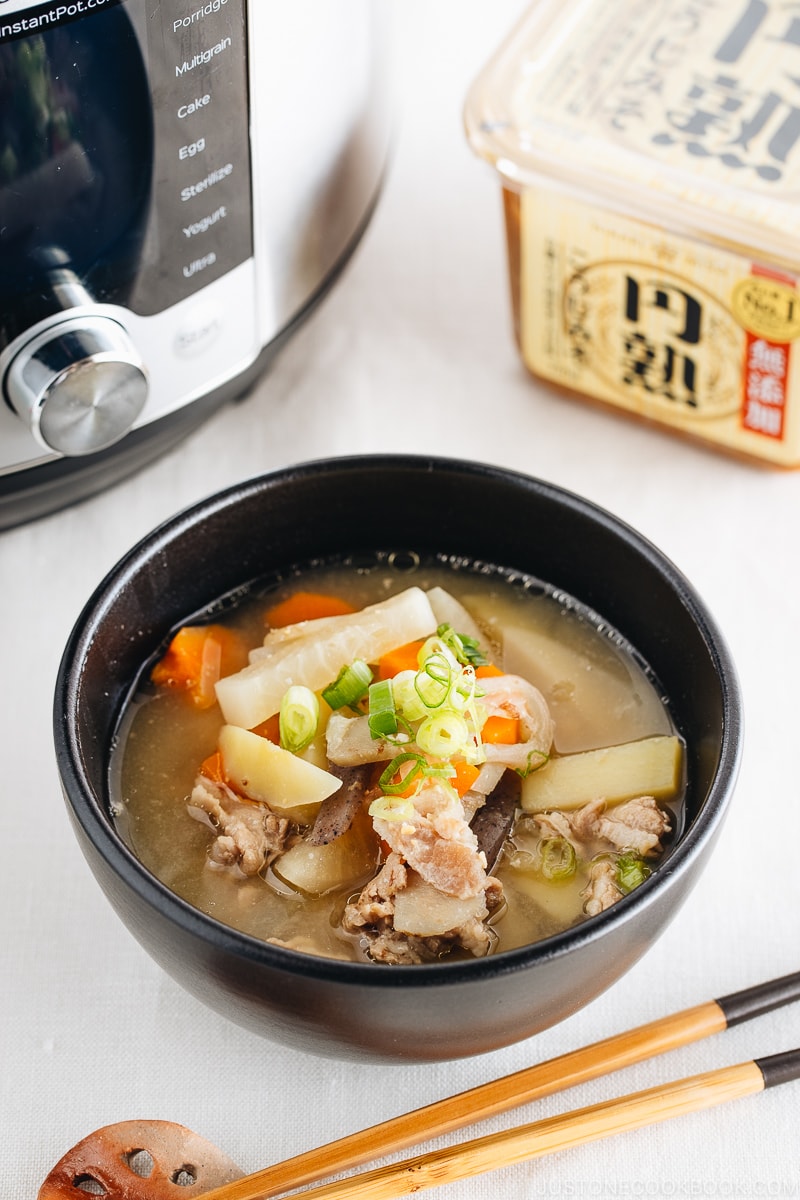
Key Ingredients for Tonjiru
Tonjiru is easy to make, especially if you already know how to make miso soup. For Tonjiru, you will prepare dashi – Japanese soup stock – ahead of time and then stir fry pork and vegetables first before adding dashi to cook them further. Let’s go over the key ingredients in detail below.
1. Pork
This miso soup won’t be called “Tonjiru” or “Butajiru” without pork (ton or buta) in it. In Japanese kanji characters, we write 豚汁 and read it Ton-jiru or Buta-jiru, depending on the Chinese reading or Japanese reading.
The cut of pork can be your choice, but in Japan, pork belly slices are the more popular choice for Tonjiru as it is more flavorful. The next choice is pork loin slices. If you cannot get ready sliced pork belly or pork loin at local Japanese/Asian grocery stores, you can cut the meat into thin slices or strips yourself (See the tutorial here).
2. Vegetables
The flavor essence of the soup comes from pork, but it actually features more vegetables. Common vegetables used in Tonjiru are root vegetables such as:
- carrots
- potatoes or satoimo (Japanese taro)
- daikon (Japanese radish)
- gobo (burdock root)
Besides the root vegetables, there are other ingredients you can add.
- konnyaku (kanjac)
- tofu or aburaage (deep-fried tofu pouch)
- shiitake mushrooms or shimeji
- bean sprouts (my mom always includes them)
- green onions/spring onions
We do not put leafy vegetables, but if you like to add, say spinach, I recommend blanching them separately and add directly to the soup bowl. This way, you can retain the bright green color and won’t overcook the leafy veggies.
3. Dashi (Japanese soup stock)
Because Tonjiru has a lot of ingredients that contribute to a decent tasting broth, you can get away by using water instead of dashi. However, my choice is always dashi because it gives more depth and umami that pork and vegetables don’t have. You can taste the difference right away.
I use the combination of kombu and katsuobushi for dashi (we call Awase Dashi) in the majority of my cooking, and this recipe is no exception. I highly recommend making homemade dashi, but if you’re in hurry, a dashi packet from Kayanoya makes a nice quick dashi in no time.
4. Miso (Japanese fermented soybean paste)
There is no specific type of miso you have to use for Tonjiru. If you like one type of miso (such as white miso, awase miso, or red miso), you can use it. If you are new to miso, read this post to get familiar with it.
For this Tonjiru, I used Enjuku Koji Miso from Hikari Miso®. I love the hint of sweetness that Koji Miso gives. More koji in the miso, the sweeter it tastes.
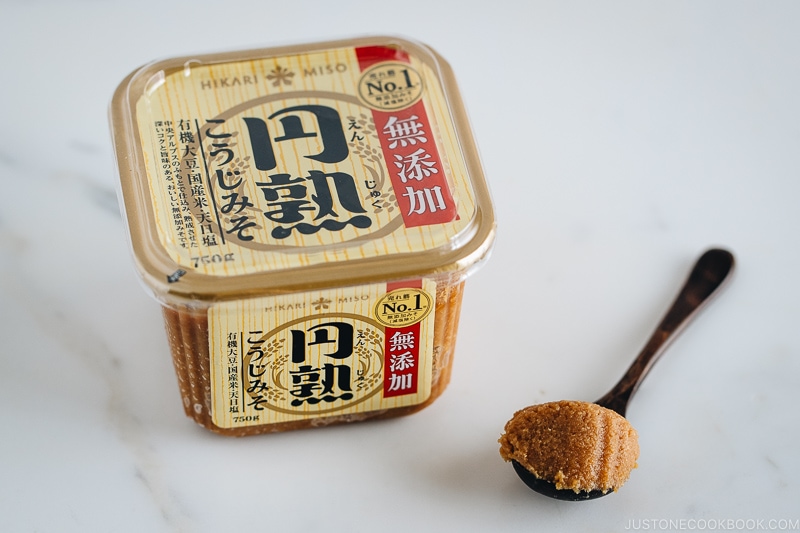
What Dishes to Serve with Tonjiru
My mom always served Tonjiru in a donburi bowl as it was the main dish, and accompany the soup with a grilled fish. Because Tonjiru has meat in it, she usually avoids meat as a main dish.
I follow the same way and usually serve a simple grilled fish such as Grilled Pacific Saury (Sanma), Grilled Mackerel (Saba Shioyaki) or Salted Salmon (Shiojake).
Tonjiru already has tons of root vegetables, so you can skip side dishes that contain similar ingredients, and instead, serve sides like:
- Tamagoyaki (Japanese rolled omelette)
- Simmered Koyadofu
- Instant Pot Kuromame
- Pickled Tomato
- Hijiki Seaweed Salad
Or if you’re really busy, just prepare a grilled fish and steamed rice, and that will still be an amazing nutritious meal!
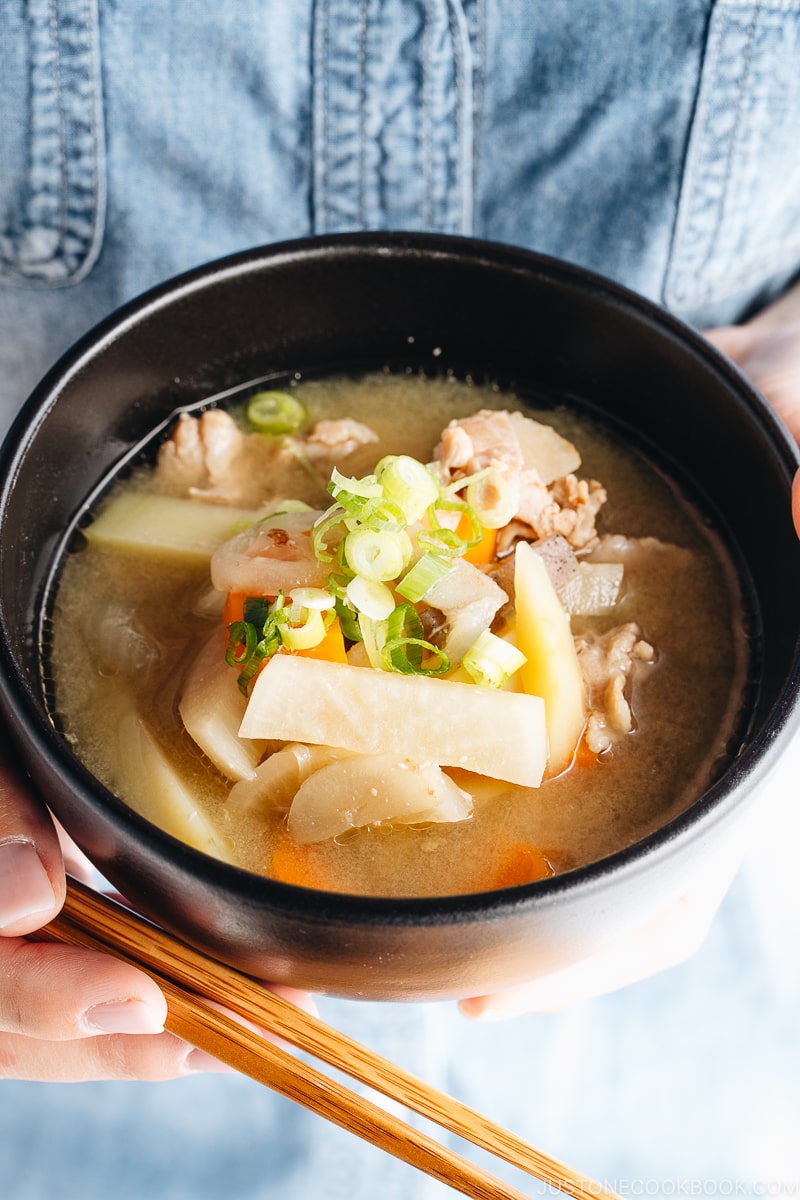
Looking for Similar Comforting Miso Soups?
- Kenchinjiru (Vegetable Miso Soup)
- Sanpeijiru (Salmon Miso Soup)
- Miso Soup with Yuzu Kosho

Japanese Ingredient Substitution: If you want to look for substitutes for Japanese condiments and ingredients, click here.
Sign up for the free Just One Cookbook newsletter delivered to your inbox! And stay in touch with me on Facebook, Pinterest, YouTube, and Instagram for all the latest updates.
Instant Pot Tonjiru
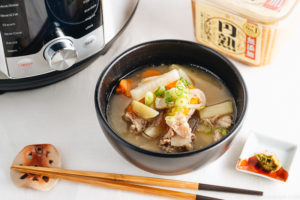
Tonjiru (sometimes called Butajiru) is a hearty pork and vegetable miso soup. With just 1 min in the Instant Pot, it will be the ultimate, comfy soup for fall and winter months!
- 2 Yukon gold potatoes ((280 g or 10 oz))
- 1 onion
- 1 daikon radish ((150 g or 5 oz))
- 1 carrot ((150 g or 5 oz))
- 1 gobo (burdock root) ((135 g or 4.8 oz))
- ½ konnyaku (konjac)
- ½ lb pork belly slices ((227 g; <strong>Tip:</strong> If you freeze the meat for about ½ hour ahead of time, it is much easier to cut))
- 6 cups dashi ((1440 ml))
- 1 Tbsp neutral flavor oil (vegetable, canola, etc)
- 2 green onions/scallions
- 8 Tbsp miso ((more or less depending on miso; I used Enjuku Koji Miso from Hikari Miso))
To Serve (optional)
- Shichimi Togarashi (Japanese seven spice)
- yuzu kosho
- Gather all the ingredients.
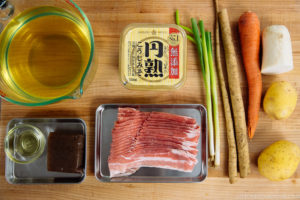
- Cut the potatoes into ¼ inch thick slabs and then cut into sticks. Soak the potatoes in water to remove the starch, for about 15 minutes.
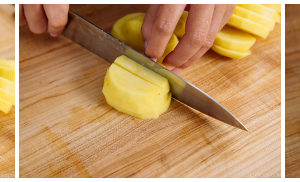
- Cut the onion into thin slices.
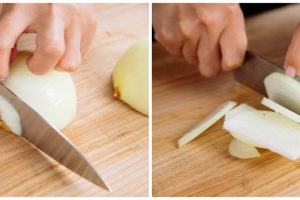
- Cut the daikon into ¼ inch thick slabs and then cut into sticks.
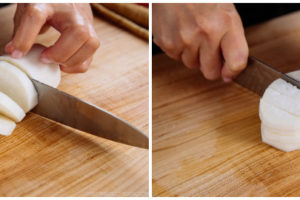
- Cut the carrot in half lengthwise, then cut into ¼ inch thick slices.

-
Scrape the gobo skin with the back of the knife. Gobo has a delicious earthy taste right below the skin; therefore, you do not use a peeler to peel off the soft skin. Cut the gobo in half lengthwise.
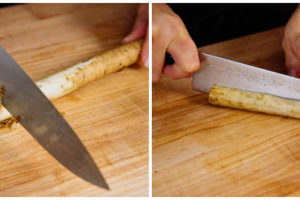
-
Thinly slice gobo diagonally. Soak in water for 15 minutes to get rid of the bitter taste. Optional: add a dollop of vinegar to the water to make the gobo white.
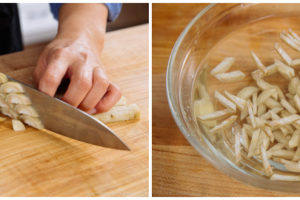
- Cut the konnyaku into ¼ inch thick slabs, then cut into sticks.
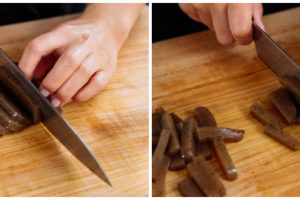
-
Blanch the konnyaku in boiling water for 3 minutes to remove the smell. Drain konnyaku with a sieve.
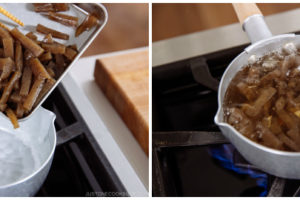
-
Cut the pork belly slices into 1 inch thick pieces. Tip: If you freeze the meat for about ½ hour ahead of time, it is much easier to cut.
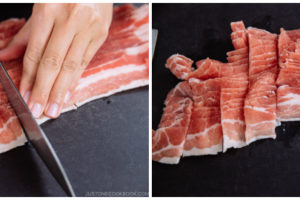
- All ingredients should be ready to go.
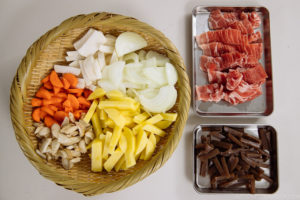
- Press the “Sauté” button on your Instant Pot and heat 1 Tbsp cooking oil.
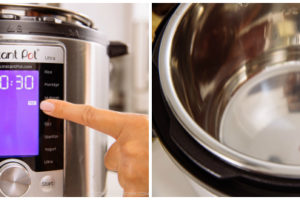
- When the oil is hot, add the onion and coat with the oil. Then add the meat and stir to combine.
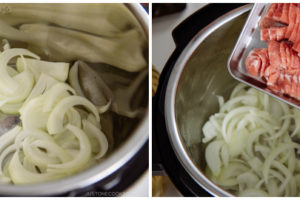
- Add all the vegetables and konnyaku.
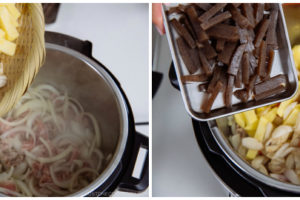
-
Stir to combine and then add in the dashi last.
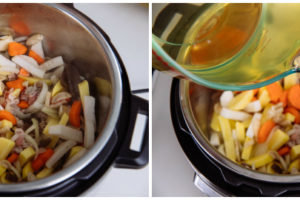
- Dashi should cover the ingredients. The vegetables will release moisture so don’t worry if you feel the soup is not enough at this stage. If dashi is not covering the ingredients, add more dashi (or water).
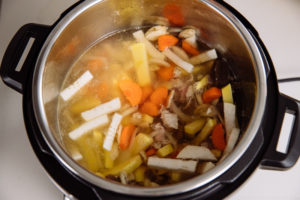
- Press “Cancel” to stop the “Saute” menu. Close the lid and press the “Manual” or “Pressure Cook” menu. Then set HIGH pressure for 1 minute. Make sure the steam release handle points at “sealing” and not “venting”. The float valve goes up when pressurized.
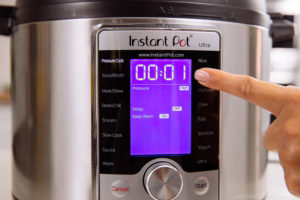
- While the miso soup is being cooked, you can cut the green onions and set aside.
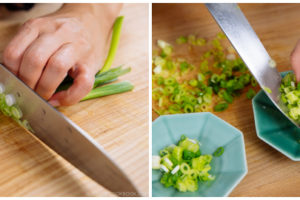
- When it’s finished cooking, the Instant Pot will switch automatically to the “Keep Warm” mode. Let the pressure release naturally for 30 minutes. If the valve hasn’t dropped yet, then quick release the air (be careful and cover your fingers with a mitten or kitchen towel).
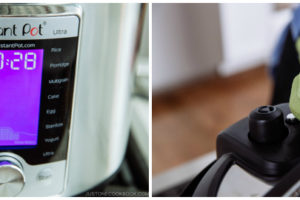
- Open the lid and check if the hard vegetables are tender.
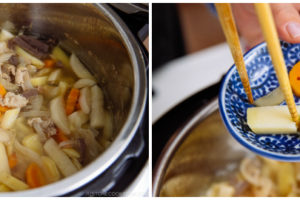
- Add miso. I used 8 Tbsp of Hikari Miso ® Enjuku Koji Miso.
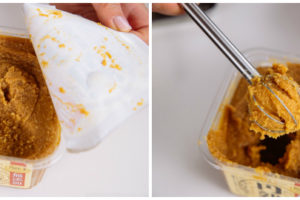
-
Dissolve the miso in a ladle before releasing it to the soup. Make sure to taste the miso soup. If you added too much miso, add dashi (or water) to dilute. If it’s not enough, add more miso ½ Tbsp at a time.
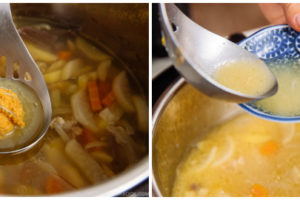
-
Pour the Tonjiru in a big bowl and sprinkle some green onions. Serve immediately. You can sprinkle shichimi togarashi or add a dollop of yuzu kosho for a spicy kick.
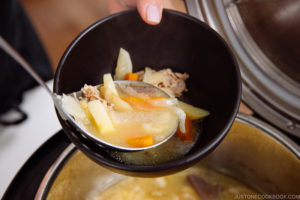
To Store
-
Let cool completely and store in the refrigerator for up to 3-4 days. When you reheat, make sure not to over boil the miso soup. Tip: The best way to store miso soup is actually to store the soup BEFORE adding miso. You can take out the portion you will need into another pot and then add miso to taste. That way, you will always have the best tasting miso soup every time.
Recipe by Namiko Chen of Just One Cookbook. All images and content on this site are copyright protected. Please do not use my images without my permission. If you’d like to share this recipe on your site, please re-write the recipe in your own words and link to this post as the original source. Thank you.
from Merah Hati Cintaku https://ift.tt/2JaCtK1
via merahhaticintaku.blogspot.my
No comments:
Post a Comment